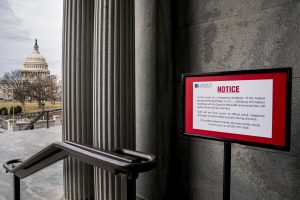
A government shutdown has effectively cleaved the federal workforce in half, sowing confusion and frustration among hundreds of thousands of affected workers, including some who reported to work Monday only to turn right back around.
“I’m on the shelf,” Rusty Payne, a furloughed spokesman for the Drug Enforcement Administration, told The Associated Press.
The partisan stalemate over the budget forced scores of federal government agencies and outposts to close their doors over the weekend. But many government functions — especially those involving national security — are considered essential and won’t be affected.
Payne and other DEA employees had been told to report to work, where they would learn their status. Payne drove to work Monday in business casual attire, a rare concession to comfort.
At the State Department headquarters, workers were streaming out mid-morning clutching white slips of paper: furlough notices being handed out throughout the day. Workers were told to show up as usual and wait to be told whether they would be sent home. All U.S. embassies and consulates overseas were remaining open, the State Department said, though some services could be reduced.
Furloughed employees are uncertain how long the partial lock-out will last and when they will be paid for the days they missed. The federal Office of Professional Management advised workers to refer to their home agency for guidance on reporting for duty.
Trump administration officials said they intend to minimize the effect of the shutdown, even though it’s estimated that almost half of the 2 million civilian federal workers will be barred from doing their jobs as the shutdown extended into Monday.
The National Treasury Employees Union, which represents about 150,000 federal workers, said many more government employees are being exempted from furloughs than were excused during the 16-day shutdown in 2013. Republicans, who controlled the House, said the Obama administration had “weaponized” the shutdown in an effort to get an upper hand during budget deliberations.
The Internal Revenue Service is preparing for the start of the tax filing season and nearly 44 percent of 35,000 of the agency’s more than 80,000 employees will report to work during the shutdown. The agency’s shutdown plan shows that most of those workers are assigned to the agency’s wage and investment division, which helps American taxpayers understand and comply with U.S. tax laws.
For offices directly involved in national security and military operations, it was mostly business as usual. Troops remain at their posts and the FBI, the Coast Guard and much more will stay up and running.
The Statue of Liberty and Ellis Island, both closed since the government shutdown, were set to reopen for visitors Monday. New York state will pick up the tab for the federal workers who operate them, according to the state’s Democratic governor, Andrew Cuomo.
But in Philadelphia, crowds of tourists were told Independence Hall, where the Declaration of Independence and the Constitution were signed, and the Liberty Bell were closed. The shuttered icons were some of the easiest-to-spot effects of the partial government closure.
Unions leaders said workers were struggling with the uncertainty that comes with not knowing when or if they will get paid.
Paychecks for the pay period that began Sunday may be affected by the shutdown, according to guidance the National Federation of Federal Employees sent to its members. Congress must approve back pay for those who work during the shutdown and also for furloughed employees.
Witold Skwierczynski works as a claims representative for the Social Security Administration in Columbia, Maryland, and is president of the American Federation of Government Employees Council 220. His members, largely workers who interact directly with the public in field offices or tele-service centers, are “pawns in this game,” he said.
“The last furlough lasted 16 days, no one got paid on time and people who live paycheck to paycheck had a crisis. People couldn’t pay their bills,” he said.
While the furloughs create consternation for some federal workers, Payne, a 15-year DEA veteran, is greeting the news with more of a shrug.
“At some point they’ll cut a deal and it will all go back to normal,” he said.
And he says there will be plenty of work to do around the house.
“When there’s a furlough my wife refers me as her manny (male nanny),” Payne said.
___
Associated Press writers Sarah Rankin and Denise Lavoie in Richmond, Virginia, and Josh Lederman in Washington contributed to this report.




